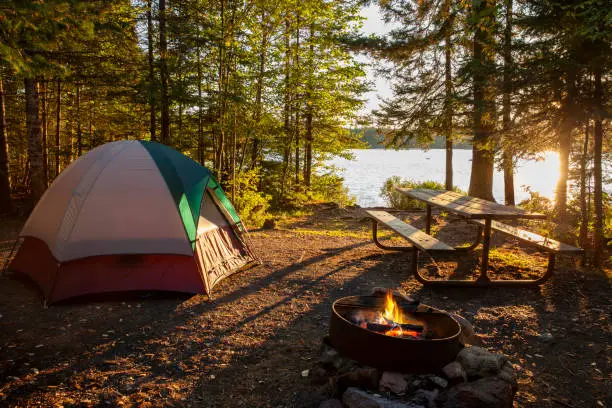Maine offers some of the most picturesque camping experiences in the United States, boasting a variety of landscapes from rugged coastlines to serene forests. Knowing what to prepare for ensures a memorable and safe adventure. Packing essential gear such as a reliable tent, sleeping bags suited for cooler nights, and a comprehensive first-aid kit is crucial for a successful trip.
Understanding the local wildlife and weather patterns can further enhance one’s camping experience. Campers should be aware of the potential for rain and pack appropriate clothing and gear. Additionally, keep food secured to prevent encounters with curious animals. For those keen on exploring Maine’s natural beauty, detailed maps and a grasp of the area’s top hiking trails can make the adventure more enjoyable. Building a checklist prioritizing safety and comfort will set the foundation for an unforgettable first camping trip in Maine.
Choosing the Right Gear
When planning a camping trip in Maine, having suitable gear is essential to ensure comfort and safety. The right selection of tents, sleeping arrangements, cooking gear, clothing, and navigation tools will enhance the camping experience.
Tents and Shelter
Selecting a durable tent is crucial. Maine’s weather can be unpredictable, so a water-resistant tent with a secure rainfly is advisable. Consider the tent size to accommodate all campers comfortably. A tent with ventilation features will reduce condensation inside. Three-season tents are often sufficient, but if camping in late fall, a four-season tent might be necessary. Also, bringing a lightweight tarp can add an extra layer of protection against moisture and increase space for gear storage.
Sleeping Bags and Pads
A good sleeping bag can make a significant difference. Due to Maine’s variable temperatures, a sleeping bag rated for colder nights ensures warmth. Examining the bag’s insulation—synthetic or down—can affect warmth and packability. Accompanying the sleeping bag, a sleeping pad is essential for comfort and insulation from the cold ground. Foam pads are lightweight and durable, while inflatable pads offer greater comfort and compactness.
Cooking Equipment
Efficient cooking gear enhances dining experiences in nature. A lightweight camping stove with fuel caters to varied meal options. Opt for versatile cookware such as a small pot and pan. Mess kits often include compact utensils and eating ware. Pack food items in airtight containers to prevent attracting wildlife. A cooler can help keep perishable items fresh if planning an extended stay. Cleaning supplies, including biodegradable soap and a small sponge, are necessary for post-meal cleanup.
Clothing for Maine’s Climate
Camping attire should be adaptable to Maine’s changing climate. Layering is key; start with a moisture-wicking base layer, followed by insulative layers like fleece. A waterproof, breathable jacket is recommended for unexpected rain. Always include sturdy hiking boots and wool socks to ensure comfort. A hat and gloves might be needed for cooler nights. Sunglasses and sunscreen protect against UV exposure, especially during hikes and outdoor activities.
Navigation and Survival Tools
Effective navigation tools are vital for safety. A trusted map and compass should always be on hand, even if GPS devices are available. Portable solar chargers ensure devices remain powered. A basic first-aid kit with essentials like bandages, antiseptic wipes, and pain relievers should be part of the gear. Multi-tools with functions such as a knife, pliers, and screwdriver are helpful for unexpected repairs. A headlamp with extra batteries ensures visibility after dark.
Selecting the Perfect Campsite
Selecting a campsite involves thoughtful planning to ensure a comfortable and memorable experience. Key considerations include making reservations in advance, assessing the features of potential campsites, and being prepared for Maine’s unique wildlife.
Campsite Reservations
Planning ahead is crucial when camping in Maine. Popular sites fill up quickly, especially during peak seasons. Reservations can be made online for many of Maine’s state and national parks. It is advisable to book several months in advance to secure a spot in your desired location. Consider proximity to amenities like restrooms and water sources. Being close to these facilities can enhance convenience but might not offer the privacy some campers seek. Assess your priorities and plan accordingly. Group size and the type of camping gear are important factors. Ensure the campsite accommodates your tent size or RV and check if there are restrictions or special conditions.
Evaluating Campsite Features
Campsite features vary widely and should align with your preferences and needs. First, consider location—a site near a lake or river provides access to water activities, while a forested area offers shade and privacy. Amenities such as picnic tables, fire rings, and grills can enhance your camping experience. Determine if these are available or if you need to bring your own equipment. Evaluate the terrain and surface type. A flat, dry ground is ideal for tents. Sites prone to flooding or with rocky surfaces might be less comfortable. Adequate tree cover can provide shelter from the elements, but ensure trees are healthy and not hazardous.
Understanding Maine’s Wildlife
Maine’s diverse wildlife is both a draw and a consideration for campers. Understanding what animals inhabit the area can help ensure safe interactions. Bears, moose, and deer are common, so it’s essential to store food securely and maintain a clean campsite. Birdwatchers might delight in Maine’s bird species, including eagles and loons. Understanding animal behavior and habitat requirements can enhance the experience and respect for wildlife. Campers should also be aware of insects such as ticks and mosquitoes. Understanding how to avoid these pests—by wearing appropriate clothing or using repellent—is essential for a comfortable stay. Environmental conditions, like the presence of wetlands, can influence wildlife in the area.
Safety and Preparedness
Planning a camping trip in Maine requires careful attention to safety. Being well-prepared ensures a smooth and enjoyable experience.
First Aid Essentials
Carry a well-stocked first aid kit, crucial for addressing minor injuries and ailments. Essentials include adhesive bandages, antiseptic wipes, tweezers, and pain relievers. Knowing basic first aid skills, such as wound cleaning and treatment of sprains, is beneficial. Personal medications should be packed in sufficient quantities. Consider adding insect repellent and sun protection to prevent common outdoor hazards. It’s advisable to download offline maps and GPS, enriching preparedness in case of emergency. Staying informed on the nearest medical facilities is also prudent.
Emergency contact numbers should be noted and shared with companions.
Wildlife Safety
When venturing into Maine’s wilderness, understanding wildlife and proper precautions is essential. Familiarize yourself with animals common to the area, like bears and moose. Food storage is key: use bear-proof containers and hang them away from camp. Maintain a safe distance from wildlife, avoiding interactions and feeding. If encountering a bear, remain calm, avoid eye contact, and slowly back away. Making noise during hikes alerts animals to human presence, reducing surprise encounters. Vehicle safety is important in moose territory; drive cautiously, especially at dusk and dawn. Encourage responsible practices among fellow campers.
Weather Awareness
Weather in Maine can be unpredictable, requiring diligent attention. Check forecasts regularly, focusing on temperature fluctuations and potential storms. Layered clothing is advisable, allowing adaptation to varying conditions and maintaining comfort. Equipment should include waterproof gear, such as boots and raincoats, ensuring dryness and warmth. Extreme weather plans should be established, outlining safe shelter options. Communication devices, like portable weather radios, provide updates on sudden changes. In colder months, be aware of hypothermia risks. Pack thermal blankets and practice safe fire-building techniques, ensuring proper ventilation and extinguishing. These practices greatly enhance safety on Maine camping trips.
Leave No Trace Principles
Following Leave No Trace principles ensures that Maine’s natural beauty is preserved for future campers. These principles include responsible waste disposal, safeguarding local wildlife and plants, and careful campfire management.
Waste Disposal
Proper waste disposal is crucial during a camping trip in Maine. Campers should pack out all trash, food scraps, and litter, leaving no trace of their stay. Biodegradable items like apple cores or peels should also be removed to prevent wildlife disruption. Human waste requires careful handling. In remote areas, dig a small cat hole 6-8 inches deep and at least 200 feet away from water sources. Use biodegradable toilet paper, sparingly. Seal used toilet paper in sealed bags to pack out. Proper waste disposal maintains the cleanliness and natural beauty of campsites. Mindful disposal habits protect the environment and enhance the experience for future visitors.
Respecting Wildlife and Vegetation
Maintaining the natural habitat of Maine’s wildlife is essential. Campers should observe animals from a distance and never feed them, as this disrupts natural behaviors and can cause harm. Pets should remain under control. Keeping them leashed or within sight ensures safety for wildlife and vegetation.
Vegetation deserves the same respect. Use designated paths to prevent erosion and plant damage. Avoid picking flowers or disturbing plants, preserving the natural landscape. Being mindful of wildlife and vegetation protects ecosystems and ensures nature’s balance remains intact.
Minimizing Campfire Impact
Campfires must be managed responsibly to limit environmental impact. Using established fire rings or fire pans helps contain the fire and prevent accidental spread. When building a fire, gather only dead and downed wood. Be sure the fire is completely extinguished before leaving the site. Douse it with water and stir with a stick until cool to the touch. In areas where fires are prohibited, use a portable stove. These practices, whether using a fire or stove, prevent damage and promote sustainability, safeguarding Maine’s natural beauty.
Activities and Enjoyment
Engaging in Maine’s natural landscape can provide endless opportunities for exploration and relaxation. Embrace activities such as hiking, fishing, foraging, photography, and journaling for an enriching camping experience. These activities not only entertain but also bring a sense of connection to the stunning environment.
Hiking in Maine
Maine’s diverse trails offer breathtaking views and challenge levels suitable for all. From the rugged paths in Acadia National Park to the gentle walks in Baxter State Park, each trail provides a unique glimpse into the state’s lush forests and rocky coastlines. Hikers should pack sturdy boots, weather-appropriate clothing, a reliable map, and plenty of water. Staying on marked trails helps protect the natural habitats and ensures hikers’ safety. Maine’s weather can change rapidly, so always check forecasts and plan accordingly.
Fishing and Foraging
Maine’s lakes, rivers, and coastal waters are ideal for fishing enthusiasts. Various species like trout, bass, and even Atlantic salmon inhabit these waters. It’s essential to obtain a fishing license before casting a line and familiarize oneself with local regulations to preserve the environment. Foraging, another engaging activity, allows visitors to discover wild edibles like blueberries and mushrooms. It’s advisable to carry a field guide to identify safe-to-eat plants. Participating in local foraging tours can enhance the experience and safety. Catch-and-release is encouraged to help maintain fish populations, and foragers should only take what they can consume, ensuring sustainable practices.
Photography and Journaling
Capturing Maine’s picturesque settings through photography can preserve memories and inspire creativity. Whether it is sunrise over Cadillac Mountain or the vibrant autumn foliage, photographic opportunities are plentiful. Camera equipment, including lenses for wildlife shots, can make a difference in the outcome of photos. Journaling offers a personal way to document the trip, reflect, and craft stories. Campers might record daily experiences, sketch wildlife, or pen observations about the weather and surroundings. Using waterproof journals ensures protection from Maine’s unpredictable climate. This combination of photography and journaling not only enriches the camping experience but also fosters a deeper appreciation for the natural world.
Now you are ready to get out there and explore! Gear up, pick a camping spot, and explore Maine.

